Microsoft Surface Pro 3 Review
by Anand Lal Shimpi on June 23, 2014 3:55 AM ESTThickness, Thermals and Core: Understanding how Surface Pro 3 Got so Thin
Ever since Surface RT showed up I've wanted Surface Pro but in the RT chassis. Microsoft seemed to consciously avoid any lower TDP Core processors in favor of Ultrabook SKUs, which pretty much kept Surface Pro thicker than its ARM-based counterpart. Surface Pro 3 changes everything with a rethinking of how Microsoft embraced the thermal constraints of a tablet.
Surface Pro 3 is available with one of three CPU options: a Core i3, Core i5 or Core i7. The latter two are 15W TDP parts, while the former is a 11.5W TDP/6W SDP Haswell Y SKU. Haswell Y is really designed for passively cooled form factors, but all three CPU options receive the same heatpipe and fan cooling system offered by the Surface Pro 3. In short, the Core i3 model should behave a lot more like a standard Ultrabook part (sans Turbo).

Surface Pro 2 (left) vs. Surface Pro 3 (right)

Apple iPad Air (left) vs. Surface Pro 3 (right)
Microsoft's claim to fame is the ability to build the world's thinnest device with a Core series CPU inside. At 9.1mm thick, the Surface Pro 3 is just barely thicker than last year's Surface 2 but with a full blown dual-core Haswell instead instead of a high-end phone/tablet ARM SoC. As both the Surface Pro 2 and Surface Pro 3 used 15W Haswell Ultrabook parts and Microsoft claims a performance increase over last year's model, the question is how Microsoft can reduce thickness, keep TDP the same and increase performance. The answer is simply a difference in what's acceptable from a thermal standpoint.
Here's a look at the original Surface Pro while running an hour long loop of 3DMark Ice Storm Unlimited. I chose this test in particular as it behaves as a nice balance between CPU and GPU workloads on the device:
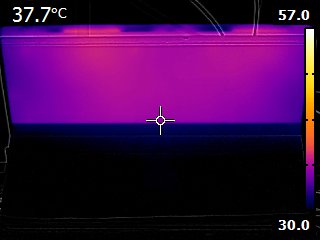
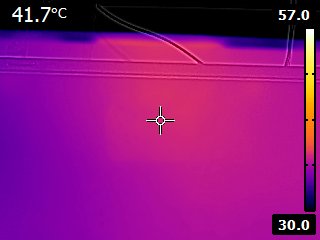
You can almost trace out the path of the heat pipe carrying the thermal load away from the CPU and to the two fans in the system. I measured peak temperature here at 41.7C.
Now let's look at Surface Pro 2:
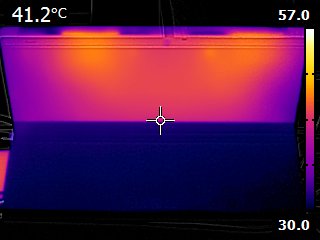
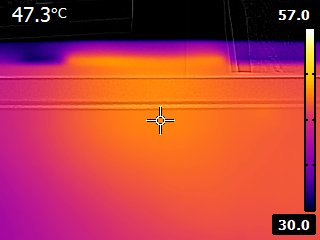
Despite a move to Haswell, Microsoft lets the device get much warmer. You can make out the same U-shape thermal distribution as heat is carried away using the two fans, but the temperatures are much higher. I measured a maximum temperature running the same workload of 47.3C.
Here we have Surface Pro 3:
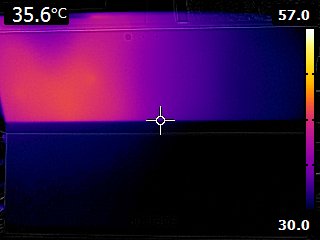
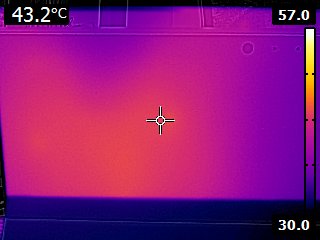
Right away you can see the new cooling system at work. The thermal load is mostly confined to the left side of the image (we are looking at the back with the kickstand unfolded towards the camera, so if you were looking at the display we're talking about the upper right side of the machine). The cooling solution is far more compact and I suspect ready for a move to Core M (Broadwell). Peak temps however are much closer to Surface Pro 1 at 43.2C.
The thermal story points us in the right direction. Either Surface Pro 3's fan and heatpipe configuration is able to remove heat far better than Surface Pro 2's design could, or the CPU in SP2 doesn't get as warm. I suspect it's the latter.
For starters, I'm guessing that Intel is helping Microsoft with delivering better binned Haswell ULT and Y series SKUs. But the big change is I believe Microsoft is more aggressive about reducing CPU and GPU frequencies in Surface Pro 3 compared to Surface Pro 2. Benchmarks will show an increase in performance due to more aggressive ramping up/down of clock speeds vs. Surface Pro 2, but prolonged load cases will likely show a decrease in performance vs. last year's model.
I first stumbled upon this behavior while trying to gather thermal data for Surface Pro 3. I noticed large run to run variance if I repeatedly ran 3DMark 11. I'm used to seeing this sort of behavior on smartphones that throttle quickly, but it was unique for a Surface Pro device.
3DMark is a synthetic test so the real question was how would Surface Pro 3 perform in a real world scenario where sustained CPU/GPU load was guaranteed for a long period of time. I figured a game playable on the machine like Dota 2 would be a great example. I asked our own Ryan Smith to whip up a custom benchmark using the game and I ran it on Surface Pro 1, 2, 3 as well as a 13-inch MacBook Air (Early 2014). The graph below illustrates average frame rate during our Dota 2 benchmark for all of the systems:
As you can see, even with Surface Pro 3's fan running the platform doesn't deliver sustained performance equal to last year's model. It's an understandable tradeoff given the substantial reduction in device thickness (and thus improvement in usability), but it's important to note nonetheless.
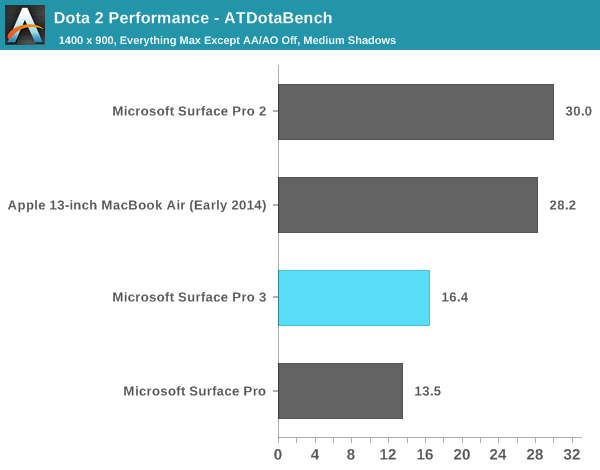
Workloads that are CPU and GPU heavy are one thing, but what about sustained productivity workloads? Penny Arcade's insanely talented artist Gabe mentioned that he noticed substantial lag when drawing on his Surface Pro 3. As Surface Pro 3's NTrig pen is actually lower latency than Surface Pro 2's, I wonder if what Gabe ran into might be thermal related rather than pen related (alternatively it could have to do with the much higher display resolution that Surface Pro 3 runs at). I needed a repeatable workload to see if non-gaming use cases also showed a regression. Thankfully PCMark 8 v2 provides a number of relatively long, repeatable workloads that are great for testing just this.
I decided to use the PCMark 8 v2 Work suite which includes web browsing, office producitivity (word processing and spreadsheet work) and video chat. It's a far cry from a Cinebench loop but I figured if I saw throttling here it would easily be present in heavier workloads. Each run of the suite actually repeats the tests three times and takes around 20 minutes to complete on the Surface devices. I measured performance for three suite runs (9 total runs of the Work loop) on both Surface Pro 2 and 3:
| PCMark 8 v2 Work Performance Over Time | |||||||
| Work Suite Run #1 | Work Suite Run #2 | Work Suite Run #3 | |||||
| Microsoft Surface Pro 3 (Core i5) | 3273 | 3031 (92% of peak) | 3129 (95% of peak) | ||||
| Microsoft Surface Pro 2 (Core i5) | 3222 | 3223 | 3218 | ||||
As you can see, there's a 9% drop in performance on Surface Pro 3 from the first suite run to the next while Surface Pro 2 delivers consistent performance between runs. By the third run Surface Pro 3's performance recovers a bit, although it's still a few percent below the initial, cool run.
PCMark 8 v2 also plots CPU temperature and frequency throughout the course of the benchmark. Unfortunately I don't think I can export the data so I'm forced to present screenshots from the benchmark harness itself. Thankfully even looking at these screenshots is enough to tell us what's going on between the two Surface Pro devices:
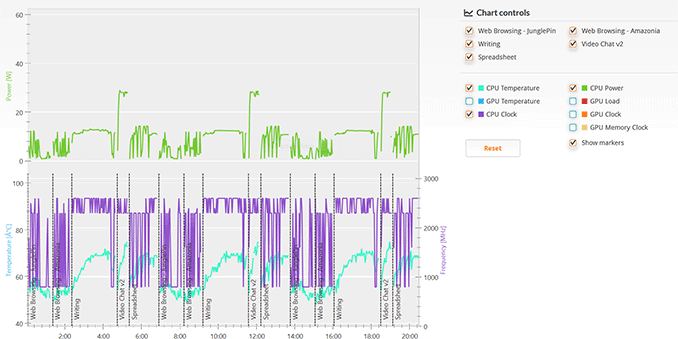
Surface Pro 2 PCMark 8 v2 Work Suite
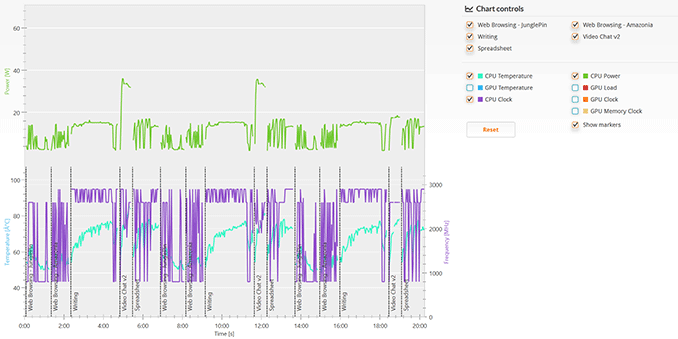
Surface Pro 3 PCMark 8 v2 Work Suite
Both devices do a good job of reaching max turbo fairly regularly, but Surface Pro 2 appears to spend more time at its max turbo state. By the last loop of the benchmark Surface Pro 3's max power is limited (green line) by the time we get to the video chat workload, I suspect that is where we lose a bit of performance. I'm only looking at the last of three suite runs here, if we looked at the second one the results would be even worse.
I haven't tested Surface Pro 3 in Microsoft's new docking station so I don't know if the device changes its thermal profile at all when docked, but in tablet or laptop mode it's definitely going to throttle quicker than Surface Pro 2 did. I must stress that I don't think this is necessarily a bad idea. Surface Pro 3 improves usability over Surface Pro 2 by leaps and bounds, and it's still faster under load than the original Surface Pro. All of this comes at the expense of reduced sustained performance. As you'll see from the rest of our tests, peak performance did get better over last year's model.
Fan Noise
Surface Pro 3's single fan is more noticeable than in Surface Pro 2. The sound it produces isn't necessarily louder, and when spinning it sounds a lot like any other Ultrabook with a fan in it. Compared to Surface Pro 2, the fan does kick in more frequently. For light tablet workloads or even light office work on Surface Pro 3, the fan remains silent. It's only when you're doing anything CPU or GPU intensive that you'll hear it spin up. The big difference is that in situations where you wouldn't hear fans spinning on Surface Pro 2, you'll sometimes hear it on SP3. This is the tradeoff that comes with the thinner chassis.










274 Comments
View All Comments
Morawka - Monday, June 23, 2014 - link
Wow SP3's Sata SSD is hanging Neck and Neck with the MBA's PCIe Based SSD. just crazycarljoseph - Monday, June 23, 2014 - link
Pretty good review. If anyone wants to get their hands on a Surface Pro 3, some folks I work for are giving a couple away in a competition. https://msgooroo.com/surfacecompkhanov - Monday, June 23, 2014 - link
Surface Pro 3 costs as much as a well specced laptop. Any decent laptop has a user replaceable battery, and many people that own laptops have replaced the battery at some point, as they generally only last a few years at best.I can't see myself spending all that money on Surface Pro 3 then throwing the whole device out just because the battery has failed a few years later. In this price bracket, Redmond need to address this issue.
nerd1 - Monday, June 23, 2014 - link
Eh... none of apple laptops have user replaceable battery nowadays.drunken - Monday, June 23, 2014 - link
I got my SP3 on Friday, so far I love it. For my use case the SP3 is perfect - productivity/development work at home and the office (visual studio, sql server, office). I'll be getting 2 docking stations when they come out for a full desktop-like setup.If I'm out and about and need to do some fixes or minor work, then the portability and capabilities of the SP3 is perfect. It's not great to use on a lap but I could definitely make do for short periods of time.
I installed a start menu which makes it function basically like Windows Pro 7. My "real work" is done in desktop mode - no need to open any apps in Metro mode.
So far I have only used at as a tablet for consumption/games in bed or on the couch. The Netflix app is great. It is a bit heavy for a tablet but I'm willing to have that slight trade-off for the 2 in 1 package. I'm really trying to use it as two different devices.
beyondabraxas - Monday, June 23, 2014 - link
What about the glued in components/built in obsolescence/ impossibility to repair?I have a story for ya'll....
I dropped my SP1, barely 15 inches onto thick and fluffy carpet, thing is, it landed on the kickstand, and the kickstand tore off, when it did tear off -- thanks to the over gluing inside, the tabs of the kickstand peeled off some other black foil like stuff, which I'm assuming was battery related since after that I'd notice kinds of 'powder' and 'sweat' which would burn with my hands - I called M$ - since it was still under warranty, However, they wouldn't fix it for me since it was considered my fault for dropping it, which I'm totally fine with, losing a kick stand, no problem, my fault for that -- whats not my fault is the kickstand being so flimsy and attached to glue inside that it would peel stuff off, thats a product problem. The kickstand can be very easy to break off, if you do, you can be boned like I was. Anyways, I had to pay $300 (in goodfaith) for a refurb exchange two months ago, in this time, they're 'supposed to be' inspecting my device to verify my claims, thats the best they could do apparently - So far, I've heard nada - And this Refurb has been a shit experience all over again, since I'm assuming the battery in the refurb wasn't replaced, and has been giving me all kinds of hassle. Its been weaker than my old surface, I've spent hours trouble shooting with support on the phone, trying to solve the 'Plugged in - Not Charging' message I'm constantly faced with - The techs determined I should send it back in for another Refurb. I say fuck that - The amount of time and headache sunk into this thing is not worth it - Once mine dies, it dies - And I'm done with Surface thanks to their shoddy construction i.e. use of glue/built in obsoletion. I'd rather get a competitors product that allows me to atleast change the battery on my $1000+ device.
I really was one of the initial proponents of this device - My friend, an animation director was an early adopter and promoter, he was supposed to do commercials with them for it, not sure what happened to that - So he turned me onto this thing, I was all about it, its (was) the perfect device for an animator/artist. Now, this whole experience with battery related stuff has left such a bad taste that I'm done with this product line. Microsoft has had a history with shoddy electronics. Like my old Xbox360(s) RODing repeatedly. Screw supporting local american brands if thats the kind of build quality one can expect.
iFixit rightfully gave the Surfaces a repairability score of 1/10. Its non existant. All batteries die eventually - IQ or not. I gotta deal with my soon to be $1300 paperweight.
Sorry for rant - I've been a subscriber and follower of this sub for too long, contributer in its early days - now I just hate hearing about surface stuff considering my shitty experiences.
I know my post is about the SP1 - you can bet the SP3 is no different. They're annual products with no chance of repairability.
Gigaplex - Monday, June 23, 2014 - link
"While the Surface Pro 2 was never quite all that comfortable to use as a laptop, Surface Pro 3's display makes it substantially more laptop-like."Except that the old 16:9 aspect ratio matches most laptops. I've never seen a 3:2 aspect ratio laptop.
nerd1 - Monday, June 23, 2014 - link
16:9 is only good for watching videos, and for productivity task vertical space matters most. Due to the 3:2 aspect ratio, SP3 is easily on par with 13.3" laptops (It has slightly taller screen than 16:10 apple laptops BTW)seapeople - Monday, June 23, 2014 - link
Everything in the review was good, but it seems a bit clipped. For example, based on the specs, one of the big upgrades for the Surface Pro 3 was the camera. Considering that the camera is an important aspect of a tablet it would be nice to have it included in the review.Next, I know you hinted that recover from standby is long, but what about boot times, or hibernate?
What about real life multitasking? Can I watch a you tube video on half the screen and work on excel on the other half, or does this stretch the thermal limits? Sometimes it's hard to tell what running Pcmark42x means in real life.
Again, I think the review was good, but it didn't really go above and beyond, so to say.
MarcSP - Tuesday, June 24, 2014 - link
Totally agree on the camera. Why do not compare it to the rear camera of the MBA13? Oh, wait! :PSeriously, it would be good to have a few paragraphs about the cameras, as well as about the new speakers.